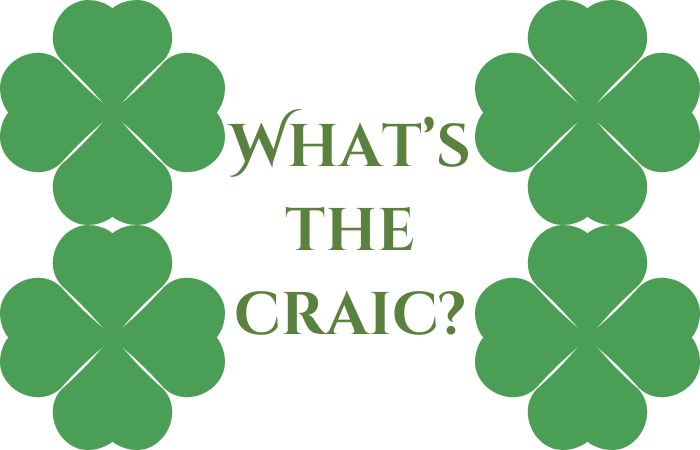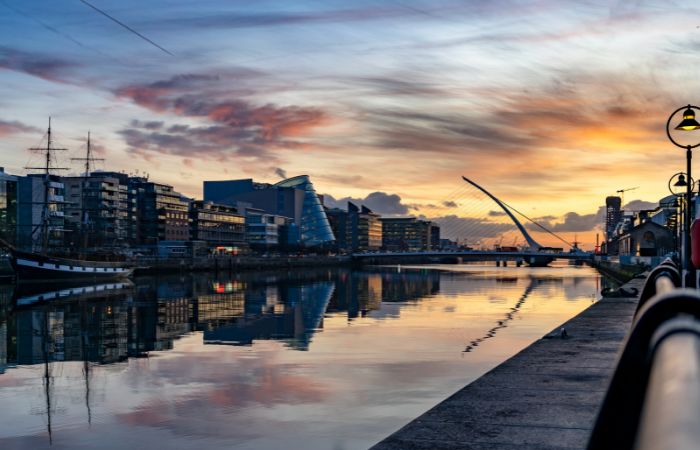Top 23 Things Dublin is Known For & Famous For
What Is Dublin Known and Famous For
They say that unless you get to experience Dublin for yourself, you won’t really know how beautiful it is. Having had the chance to visit the Irish capital several times myself, I can fully attest to this saying.
Dublin is widely known as the idyllic home of some of the world’s literary greats. It’s also famous for its pubs, the warm and welcoming nature of its people, and its breathtaking scenery. You can also enjoy its historic castles, museums, and folk music.
It’s usually the pubs that folks flock to in Dublin. And sure enough, you’ll find good booze and jolly company there. But there’s so much more to Dublin to experience, so let’s look at some of the most interesting facts about this lovely city.
Disclaimer: This post may contain affiliate links. We may earn a small commission for purchases made through links in this post, at no extra cost to you.

Friendly People
Irish people are known to be among the friendliest people on the planet. In Dublin, you will meet the warmest folk you will ever encounter in your life. No wonder so many foreigners find it hard to leave once they’ve been to Dublin.
Dublin is also big on social gatherings and events held in pubs, restaurants, and homes. Dubliners are also very welcoming to foreigners. So if you’re worried about not having friends or relatives in Dublin, there’s no need to. With folk as friendly as Dubliners, chances are you will quickly make friends.

Irish Craic
True to the Irish love of fun and merriment, they are also known to crack a joke on every occasion. In fact, the “Irish craic” means love of laughter, fun, complete trust, and interest, but it also means the enjoyment that can be had by being together, socializing, enjoying a pint or two with friends, and even sharing the latest gossip!
Often, the Irish word “craic” (pronounced “crack”) is used in expressions like, “What’s the craic?” which means “What’s the latest gossip?” or “What’s up?” If a local greets you with this expression, don’t panic. You can simply respond by saying, “Same old.” (Or give a few deets about yourself if you want!)

Dublin Means Black Pool
Did you know that the name “Dublin” is actually a traditional Irish word that literally means “black pool” or “dark pool”? Back when the area was a Viking settlement, they saw a pool of black water on the site, thus inspiring the name.
This black pool was actually caused by a drainage channel that created a pool of murky water, which was actually a spot where two rivers, Poodle and Liffey met and mixed together. The dark color of the water was believed to be due to peat staining.

Baile Atha Cliath
While we know the city as Dublin today, its official Irish name is actually Baile Atha Cliath, which literally means “Town of the Ford of the Hurdle” or “Town of the Hurdled Ford.” This is believed to be because it is the location of a fording point made of hurdles out of saplings. This same area is also where four main roads intersect.

Mild Temperatures
One of the reasons why tourists flock to Dublin is its mild climate. Its winters are cold, but not too cold. Although if you’re not a fan of freezing temperatures, you might want to schedule your visit in summer. Summers in Dublin are quite comfortable. You get to enjoy some sun without it being too hot.
If you do insist on coming down in winter, prepare to see some rain, as it can get a bit wet at that time of the year.

The Brazen Head Pub
If you’re looking to share a drink with friends and take in some history while you’re at it, you might want to drop by The Brazen Head, the oldest pub in Ireland. Its building was built in 1754, but they say that The Brazen Head Pub has been mentioned in a few documents dating back to 1653. Before the pub,the location was a tavern / alehouse and has been serving drinks a lot longer than 1653. The site claims to be the oldest pub in the city and says it has been serving customers drinks since 1198.
Today, it’s not just a pub but a unique place where you get to experience the old Irish architecture and culture.

A UNESCO City of Literature
With some of the biggest names in literature originating from Dublin (James Joyce, William Yeats, Oscar Wilde, Samuel Beckett, and more), it’s no wonder that Dublin was named a UNESCO City of Literature in 2010. It is only the fourth City of Literature in the world.
This recognition is not only due to the literary achievements of its long-gone writers, but also because it has, up to this day, a dynamic and vibrant creative culture where artists and writers thrive.

Phoenix Park
The Phoenix Park is a vast park in Dublin, so huge that it’s twice the size of Central Park in New York City. It is also the biggest park in all of Europe and is the perfect place to escape to if you want a huge dose of nature within the bustle of the city.
The park is open throughout the year, and there you’ll be able to see attractions such as:
- Dublin Zoo
- Farmleigh Estate
- The President’s Residence “Aras an Uachtarain”
- People’s Flower Gardens
- Historic monuments

Sugarloaf Mountain
If you want to take your outdoor Dublin experience to the next level, you can always go to the Great Sugarloaf Mountain. Locals say a hike to this mountain will give you the best view in all of Dublin. The climb will take you roughly 2 and a half hours, and the terrain is friendly enough for hikers of all ages.
Sugarloaf is situated northeast of the Wicklow Mountains overlooking the town of Kilmacanogue. If you do decide to take the hike up there, don’t forget to bring a camera to capture the spectacular view.

Oscar Wilde
A fan of Oscar Wilde? Then you must know that the writer was born and raised in Dublin. In fact, Dublin loves Wilde so much that the city continues to pay homage to the writer until today.
In Dublin, you will find the Oscar Wilde Memorial in Merrion Square Park, the Oscar Wilde House (Wilde’s actual childhood home that was restored to feature the lovely architecture of the time and the house’s actual furnishings) within the Irish American University, and an Oscar Wilde statue. Even Wilde’s birthplace is considered a historical landmark today.

St. Patrick’s Cathedral
Ireland is known to be Catholic, and the St. Patrick’s Cathedral is one of the biggest testament to the deeply Catholic traditions of the Irish people. The Cathedral is the national cathedral of the Church of Ireland today.
But aside from its religious relevance, St. Patrick’s is also a popular tourist destination because of the church’s majestic architecture that dates back to 1911. It is also well-known for its choir, which many tourists make it a point to come to hear.

St. Valentine Resides in Dublin
Feeling romantic? Dublin could be just the place to go. Did you know that the remains of the patron saint of love, St. Valentine himself, are in Dublin? He was executed in Rome and buried there, but his remains were later exhumed and brought to Dublin.
Wonder how that came to be? An Irish priest, Fr. John Spratt, was, amazingly, able to convince the pope to exhume the remains of Valentine in order to bring them to Dublin as a gift to his fellow Irishmen.

Dublin Castle
If you really want to take in the history of Ireland, you should not miss Dublin Castle. This is known to be the historical powerhouse of Ireland. Built in the 13th century by King John of England, it has now been standing for 818 years.
Today, it’s a government complex where state and presidential events are held, but it’s also open as a tourist attraction. However, it used to be a British military fortress and a prison before it was handed over to the Irish government upon the country’s independence.

Grafton Street
Now for those who are looking to shop until they drop, make sure you visit Grafton Street in Ireland. Stretching from St. Stephen’s Green to College Green, you will probably tire your feet out before going into all the shops that line this long street.
It is known to be the busiest shopping street in Europe, and is one of two shopping districts in Ireland. Be prepared to see hordes of people gathered here, as it’s not only a known shopping destination but also a popular meeting place among locals and tourists.

River Liffey
This river is part of what’s called the Trinity: River Liffey, Dublin Bay, and the city. It has been used by the Vikings for trade, and is very much a vital part of the city even today. Much of Dublin’s water comes from River Liffey, and several recreational water activities are made possible because of it as well.
As it streams through the center of Dublin, it practically divides the city into the northern and southern parts. It also flows into Dublin Bay.

Temple Bar
Temple Bar is an area south of River Liffey bustling with activity–from tourists going exploring to locals getting their fix at the pubs. True to its name, this stretch of road is lined with pubs that host live concerts and other events (the folk music is definitely something to check out!), which is why the place never runs out of a crowd.
Moreover, this is where you’ll find Temple Bar Pub, where you can marvel at the biggest collection of whiskey in all of Ireland.

Pubs
We all know that Dublin–in fact, Ireland–is known for its many, many pubs. There are so many pubs scattered all over the city that it would be hard to ignore them or resist going inside one. And that’s not surprising, given that the Irish are known to be big-pub-goers and beer lovers.
Don’t have time to fit all of the city’s pubs in your itinerary? Here are some of the best that you might want to make time for:
- The Liquor Room
- Temple Bar Pub
- The Brazen Head Pub
- John Kavanagh’s
- Bowes
- The Long Hall
- Toners
- The Cobblestone
- The Blue Light
- Davy Byrne’s Pub
- The Foggy Dew

Guinness
You’d be missing out if you don’t try a pint of Guinness in Dublin. If you don’t know it yet, Ireland is where Guinness originated. And while the drink is now available in many parts of the globe, experts say that Guinness is different (and way better) in Ireland.
And if you think this is all just local bias, there was in fact, a study already conducted to test the appearance, flavor, and aftertaste of Guinness in Ireland, comparing it with that available in other countries. The result? Each pint of Guinness from Ireland scored up to 100, while those from other countries could only reach up to 74.

Trinity College
Trinity College Dublin is considered a leading educational institution in Europe, known as an international center of research and scientific disciplines. While it does not belong among what’s known as the circle of Ivy League schools, it has been called one of the Little Ivies. Therefore, I highly recommend paying it a visit.

The National Museum of Ireland
The spectacular National Museum of Ireland, established in 1877, is considered the finest museum in the country. It features works of archaeology, decorative arts and history, country life, and natural history. The best part about it? Admission is absolutely free. If you’re a history buff, you don’t want to miss out on this attraction.

Irish Folk Music Scene
Aside from Guinness, Dublin is widely known for its traditional Irish folk music. In fact, its pubs play a big part in the perpetuation of Irish folk music, as these are often the venues for live concerts and music festivals.
If you want to experience the Irish folk music scene for yourself, you might want to drop by O’Donoghues to get a pint of Guinness while watching live bands perform.

O’Connell Bridge
The O’Connell Bridge is one of the major bridges in Dublin. It is also a traffic bridge over the River Liffey and is popular among tourists as a beautiful photo op spot. This bridge was opened in 1794 and connects the south of Dublin with the North. So if you’re looking to take a breathtaking picture to make all your friends and family wish they were there with you, this is the spot to do it.

Howth Cliff Walk
This Howth Cliff Walk is a long road (It takes approximately 2 hours to walk the whole way) that offers an awe-inspiring view of the sea. It outlines Howth Head and is a great place to go running or go on a leisurely hike with friends. This is an especially excellent attraction for visitors on a budget.

Conclusion
From its incomparable Guinness, pub lifestyle, folk music, and warm, friendly people, Dublin is definitely a destination you’ll want to visit at least once in your life. And when you do get the chance to go, don’t be surprised if you find it hard to leave at the end of your trip.

Sources
- B&B Ireland: Common Irish Sayings and Their Meanings
- Britannica: Dublin
- Wikipedia: Dublin
- In Your Pocket: Dublin: A Short History
- US News Travel: Best Times to Visit Dublin
- Brazen Head: Story
- Ireland: Dublin’s Phoenix Park
- St. Patrick’s Cathedral Dublin: Home
- Irish Central: Love-Seekers Show Up at Valentine’s Resting Place in Dublin
- Dublin Castle: Home
- Irish Central: Scientists Say Guinness Does Taste Better in Ireland
- Viator: O’Connell Bridge